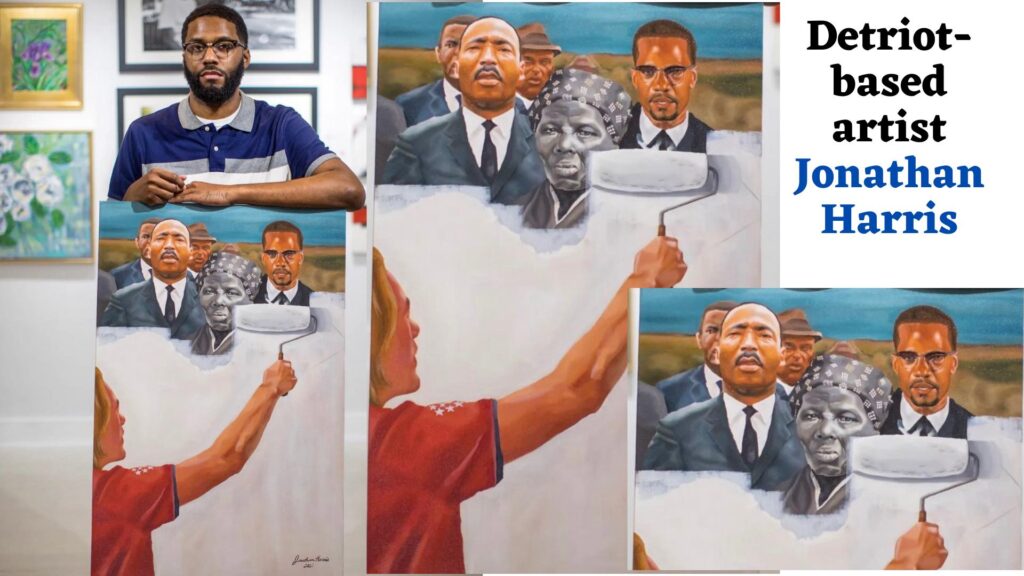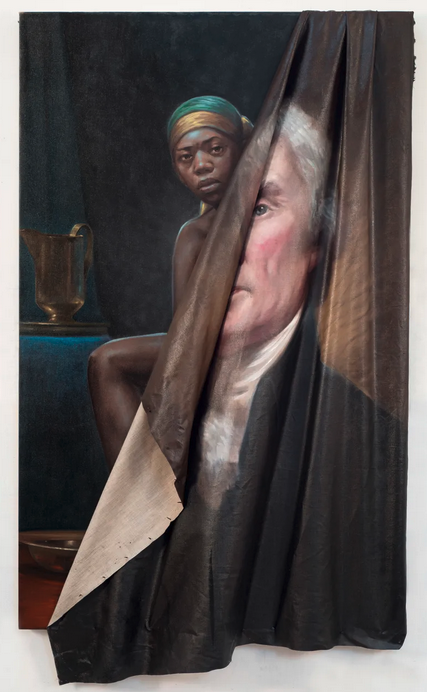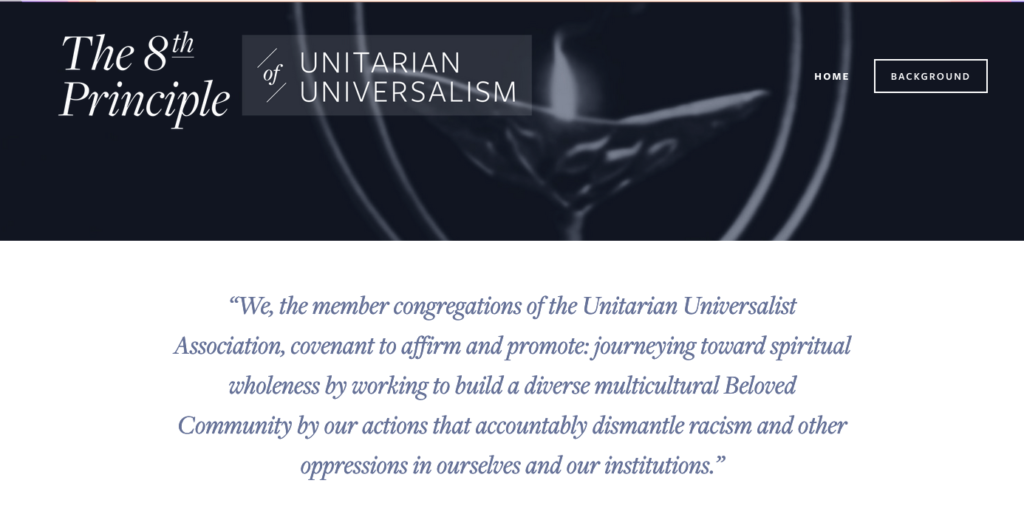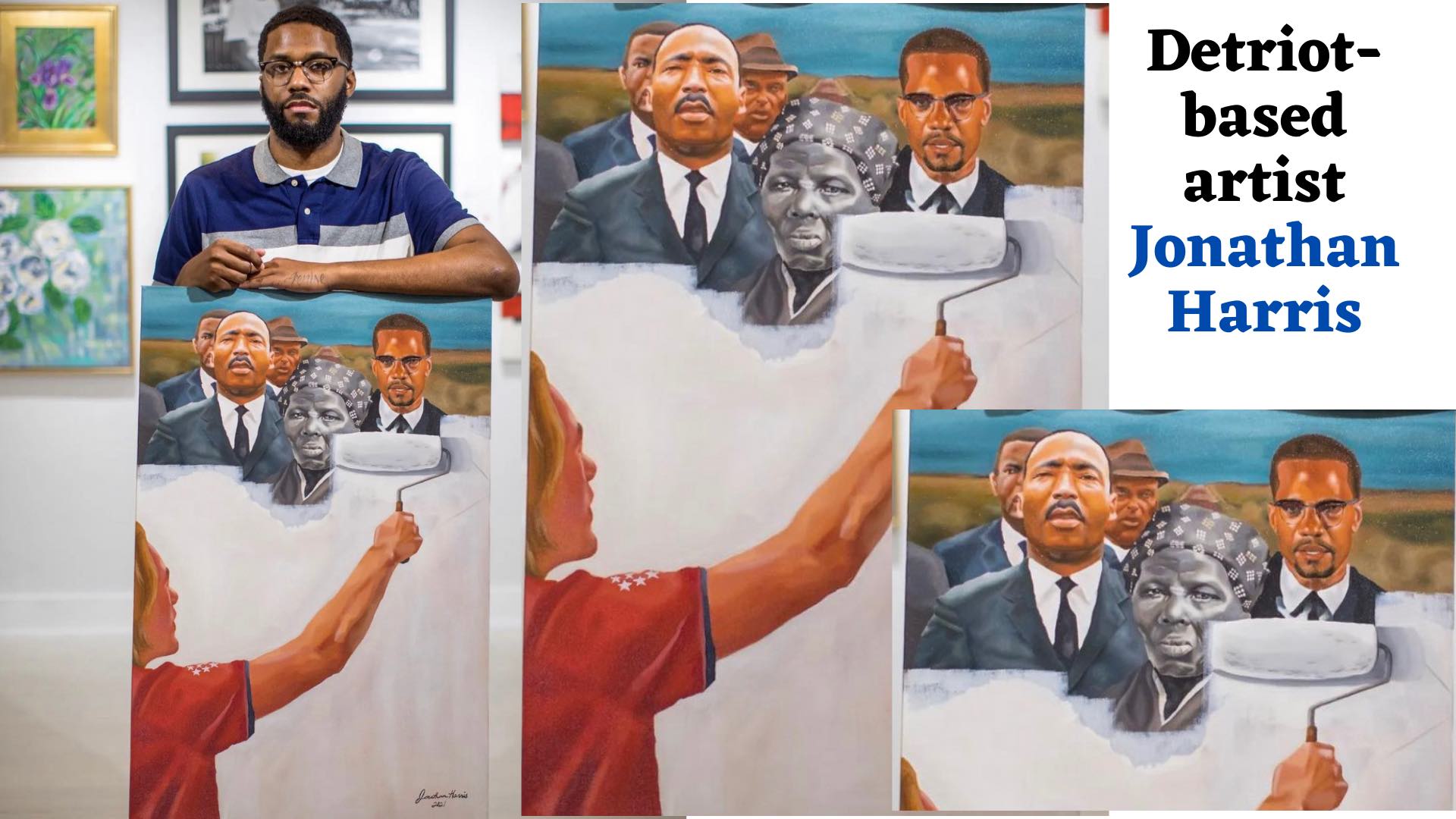
When I look at this painting by Jonathan Harris, a painter based in Detroit, and when I spend with it the time it deserves, I feel sad in my body. When I just breeze past it, observe it quickly, judge it one way or another, I can get away with an intellectual engagement, one that keeps me separate, one that keeps me aloof just enough to move through my day, as my day typically demands.

But when I slow down, I feel an aching sadness.
When I slow down and really look at it, I see the young white person, whom I perceive as male, moving his paint roller in wide, broad strokes. I perceive the opaque swaths of white pigment, how they completely obscure what was behind there.
I can see the images of Malcolm X, of Rev. Dr Martin Luther King Jr, of Harriet Tubman. There are two other figures whose semi-obscured faces we can see. I have guesses about who they are – in all the articles I read about this painting, these people were never named. This strikes me as strange. One looks to me like Harry Belafonte during the Civil Rights era. One strikes me as a possible Cassius Clay who would become Muhammad Ali.
And there is a wide white space that the white character has already covered up, has already whitewashed. It’s more than half the canvas. I think that’s important. More than half.
It’s easy to bypass that space, to stay focused on Malcolm, Martin, Harriet. If we go too fast, move onto the next thing, we just might even forget to give that whitewashed space our attention.
But let’s do it now. Let’s look there. What’s been covered up? What’s been whitewashed away? What has been taken from us? From all of us?
I am not sure when Jonathan Harris painted this. I do know that news of its existence went viral last month. It is a picture that is worth more than a thousand words. And yet, it is not the only painting to utilize this conceit of hiding history.

Titus Kaphar, a painter, sculptor, filmmaker, and installation artist, is known for how his art reveals what is hidden. I think this painting, “The Myth of Benevolence” from 2014 may be his most recognizable. It’s certainly the first painting of his that I encountered. And it has left a lasting impression.
In it, I recognize Thomas Jefferson, one of this nation’s founding fathers, so often lauded, sometimes falsely claimed as Unitarian. Hidden behind the laudable image of him is the truth of Sally Hemings, the woman too often called his “mistress” but whom, if we are being real, was someone he enslaved, someone he kept enslaved her whole life long, someone who because she was enslaved and coerced could not consent to a mutual relationship; therefore, someone he raped repeatedly which led to the birth of six children; two who died in infancy; two whom Jefferson freed in 1822; and two of whom were freely only upon his death in 1826, but not Sally Hemings. He did not free her. His daughter did. He did not. It’s hard to see that Jefferson until someone – in this case, Titus Kaphar – removes the curtain.
If we look behind the curtain, we can see the truth of this.
This painting is so starkly revealing, so real, so painful, so truthful. It’s uncomfortable. It’s more than that: it’s disturbing. For me, as a person, as a white person,I find it mesmerizing, but not in a good way. I find it agonizing, troubling, ominous, unnerving, alarming.
I must repeatedly commit myself to manage my aversion to it…and I sense that part of my liberation, and part of our collective liberation, lies within my ability, and our ability, to gaze upon it, to accept the truth-telling it offers, and to integrate this into our knowing and being.
It is not easy to sit with the truth of either of these paintings – the stories they intend to tell and the fact that there is a spreading clamor to avoid such discomfort, to ban such essential truth-telling in our public schools and shared civic arenas.
The controversy in our national midst says it’s about Critical Race Theory. But it’s not. Because Critical Race Theory is a particular thing. A legal framework. One that arose in the 1970s, typically credited to law professor Derrick Bell. One that arose as legal scholars tried to understand how racial inequalities continued despite civil rights triumphs in the 1960s.
What the folks who would ban the graphic novel Maus in a Tennessee school library, or who support the myriad legislation appearing in different municipalities (cities, counties, school districts, states) that proports to ban CRT, even to the point of reporting teachers for what they are teaching – they are not fighting this relatively arcane legal theory taught in law school.
No, what they are up to is something much more dangerous. As backlash to the social justice summer of 2020 after George Floyd was murdered, and as a way to detract from and dissipate the attention to the January 6th Insurrection, conservative forces created the political bogeyman of “Critical Race Theory,” declaring that it is being taught in K-12 schools to make Americans feel bad about America. To make white kids to learn to hate themselves for being white.
Balderdash. More obfuscation.Whitewashing the whitewash.
I call bs. And I hope that you do, too.
Dr. Yohuru Williams, the Director of the Racial Justice Initiative at the University of St. Thomas says that these folks, while they say that they are against CRT – Critical Race Theory – they are, in fact, against a different CRT: Culturally Responsive Teaching. He defines Culturally Responsive Teaching as developing and teaching a curriculum that reflects the community where it is taught – whether that is local, state, or country-wide.
Not just as it applies to race and ethnicity, but also as it applies to full inclusion of humanity: religious perspectives beyond hegemonic Christian ones; LGBTQI+ communities – sexual orientation and gender identity, inclusion of those with disabilities and those who we understand to be neuro-atypical,aspiring to a fuller, more textured, more accurate telling of history, of politics, of social studies.
Of how it is we came to be; of who it is we are.
If you go online and see what is happening out there – the governor of Virginia establishing a hotline so that parents can report so-called “divisive” teachers – it’s discouraging, even demoralizing when we see it in the wider context of the threats to our democracy. And while we might think the threats are all in red states, we must be careful. For every purple state and even in blue states, there are those who are clamoring, and in some places, gaining traction. There are New Jersey voices, and not only in red South Jersey, who don’t want children in public schools taught according to what is, as of a year or so ago, law in New Jersey, updating the learning standards to promote “economic diversity, equity, inclusion, tolerance, and belonging in connection with gender and sexual orientation, race and ethnicity, disabilities, and religious tolerance.”
Alongside these sources of dismay, there IS hope. Like this change to the learning standards. No doubt more hope than this next little example I offer you to bring to a close this first half of my sermon.
Like these words, written by a white Southern man named Mark Wingfield, on the website Baptist News Global, published earlier this week. His warning is a powerful one, far more powerful than any words I might offer:
We cannot fail to connect the dots between this attack on public education and the larger political maneuverings in our nation. This is, at root, about Christian nationalism and more specifically, white Christian nationalism. This is motivated by racism, fear of science and a desire to rewrite history. It is taking the failed tiki-torch-lit slogan of “Make America Great Again” and applying it to public education.
Part II
the failed tiki-torch-lit slogan
of “Make America Great Again”
and applying it to public education.
It is important to understand this hullabaloo about so-called Critical Race Theory in its wider context. Is it a distraction so that conservative forces can continue their tragically effective effort to disenfranchise voters of color as the Supreme Court continues to allow the gutting of the Voting Rights Act of 1965? Is it backlash against real victories like holding accountable the police officers who murdered George Floyd? It is a death rattle in the face of what has been called “the browning of America” as we get closer to the date when this nation becomes “majority-minority” and non-Latinx whites will no longer make up a majority of the population?
I’m going to say yes to all three. Yes, it’s a distraction. Yes, it’s a very real backlash. And yes, it’s a collective response to shifting tides of representation and power in a nation that has never, never been able to live up to its stated aspiration of being a true and fair representative democracy.
So what is ours to do?
- Teach ourselves, teach our children and our grandchildren histories that are real, that tell the truth, even if we don’t yet know, even when we don’t quite know how to answer the hard questions that will arise.
- Educate ourselves, but not in isolation. Educate ourselves in community, in conversation, across identities of difference. Educate ourselves not to be self-satisfied as if that is the end goal. Educate ourselves and then let what we have learned move us into new relationships, new comfort zones, new actions that influence and make a difference for others.
- Pay attention to what is happening on our local school boards. I’m so thankful for TUS member Bonnie Wilson who is so informed about East Brunswick politics and who spends a lot of time educating others about worrisome behind-the-scenes dynamics ~ and she does this from a foundation of building inclusive, welcoming community spaces. She has caught flack for this, but she is one hell of a justice fighter!
- You can become active in the Lost Souls Public Memorial Project. I mean, talk about removing the whitewash of forgetting and the willful hiding-away of a horrific chapter of local slavery history! This multi-racial group of people continues to uncover history related to the 137 African American women, men, and children sent to the Deep South and permanent slavery in 1818 – including one of whom survived long enough to be counted in the 1870 census and whose descendants also lived for decades and decades after she died. Eliza Thompson. Pretty amazing. When I have my Lost Souls Public Memorial Project hat on and I meet people who don’t know about the Van Wickle Slave Ring, I’m not surprised. It’s a history that has been whitewashed, has been hidden. What surprises me ~ worries me deeply ~ is that there are so many white people who don’t know that there was slavery in New Jersey. So much is already missing from our education, it’s hard to understand what else those folks clamoring for removal of so-called Critical Race Theory could want.

And today. A thing you can do today. In our congregation. You can vote to adopt the 8th Principle. I will not even pretend objectivity here. I have an opinion, it is a solid one, and I cannot hide it. I hope this congregation votes to adopt. If you do not, I will love you all the same. If there are individuals here who vote against, I will love you just the same. And I think it serves no one, and not this congregation, for me to pretend that I am neutral on this topic.
You can help this congregation openly and clearly declare and proclaim that we are strong enough to face our histories, the good, the bad, and the ugly, and that, in fact, we believe that our collective liberation necessitates that we do so. That our collective liberation – not any one individual’s personal salvation, but all our collective liberation – is built on the accountable dismantling of systems of oppression – that this includes truth-telling when it comes to history, when it comes to current events.
Not just today, but the coming months and years. Pay attention to the Article II Commission at the UUA which is reviewing that aspect of the by-laws which contain our beloved Principles and Sources; which will be proposing revisions, upon which delegates at the 2023 and 2024 General Assembly will be voting.
Not just today, but the coming months and years: what will it mean for us to take seriously the 8th Principle in the regular functioning of our congregational life? How do we make the adoption of the 8th Principle – should the membership vote to do so at our imminent congregational meeting a verb, rather than a noun; a living, breathing entity, rather than something that gathers dust on a shelf? How might we accept the invitation not only to integrate the values of the 8th Principle into our congregational life, but into our personal lives as well?
Let us be a part of this nation that gives no foothold to whitewashing history and education. Let us be a people, as individuals and as a congregation, who commit, as the 8th Principle describes, to building “a diverse multicultural Beloved Community by our actions that accountably dismantle racism and other oppression in ourselves and [in] our institutions.”
So be it. See to it. Amen.
Postscript: the congregation voted unanimously to adopt the 8th Principle. The real work continues…
